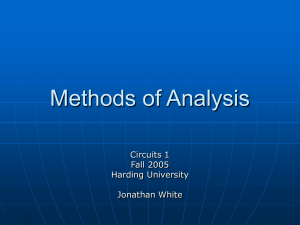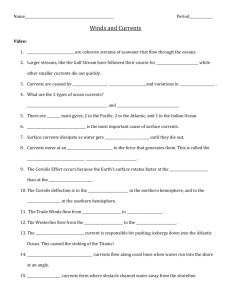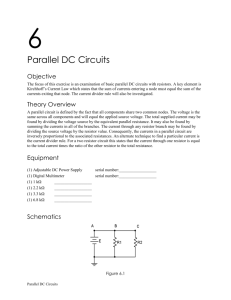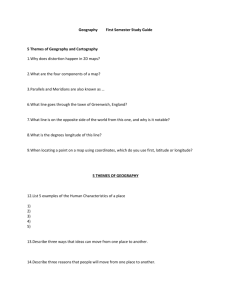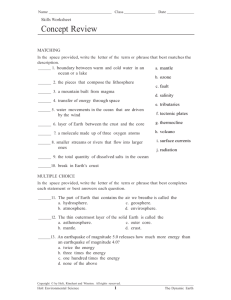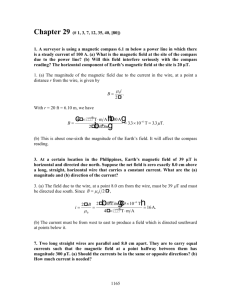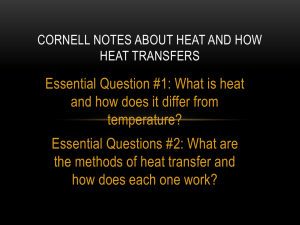Lab3_withAnswers
advertisement
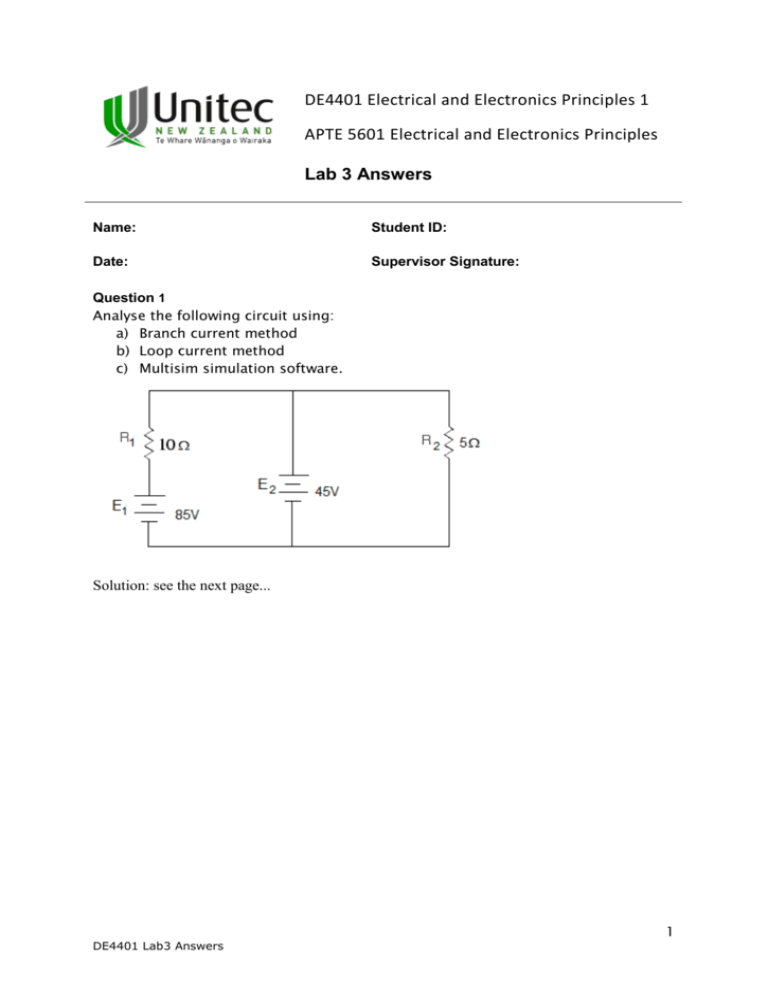
DE4401 Electrical and Electronics Principles 1 APTE 5601 Electrical and Electronics Principles Lab 3 Answers Name: Student ID: Date: Supervisor Signature: Question 1 Analyse the following circuit using: a) Branch current method b) Loop current method c) Multisim simulation software. Solution: see the next page... 1 DE4401 Lab3 Answers Solution: a) Branch current method: 1. Choose a node and assume directions of currents. 2. Write a KCL equation relating currents at the node: 𝐼1 + 𝐼2 − 𝐼3 = 0 3. Label resistor voltage drop polarities based on assumed currents. 4. Write KVL equations for each loop of the circuit, substituting the product IR for E in each resistor term of the equations. 𝐸1 − 𝑅1 𝐼1 − 𝐸2 = 0 2 DE4401 Lab3 Answers 𝐸2 − 𝑅2 𝐼3 = 0 5. Solve for unknown branch currents (simultaneous equations). Three equations from which we find three unknown currents are: equation(1): 𝐼1 + 𝐼2 − 𝐼3 = 0 equation(2): 𝐸1 − 𝑅1 𝐼1 − 𝐸2 = 0 equation(3): 𝐸2 − 𝑅2 𝐼3 = 0 First we enter the values we know (Rs and Es from the schematic): equation(1): 𝐼1 + 𝐼2 − 𝐼3 = 0 equation(2): 85 − 10𝐼1 − 45 = 0 equation(3): 45 − 5𝐼3 = 0 From the equation (2) we can calculate current I1 directly as: 85 − 45 40 𝐼1 = = = 4𝐴 10 10 Thus: 𝐼1 = 4𝐴 From the equation (3) we can calculate current I3 directly as: 𝐸2 45 𝐼3 = = = 9𝐴 𝑅2 5 Thus: 𝐼3 = 9𝐴 From the equation (1) we calculate current I2 𝐼2 = 𝐼3 − 𝐼1 = 9 − 4 = 5𝐴 So, 𝐼2 = 5𝐴 If any solution is negative, then the assumed direction of current for that solution is wrong: this is not the case here, all assumed direction are the actual current directions. 6. Solve for voltage drops across all resistors (V=IR). Using Ohm’s law: 𝑉1 = 𝑅1 𝐼1 𝑉1 = 10 ∙ 4 = 40V 𝑉2 = 𝑅2 𝐼3 𝑉2 = 5 ∙ 5 = 25V Conclusion (how to the simulation compare with calculation): ……………………………………………………………………………………………….. 3 DE4401 Lab3 Answers a) Loop current method Steps to follow for the “Loop (Mesh) Current” method of network analysis: 1. Draw currents in loops of circuit, to account for all components. 2. Label resistor voltage drop polarities based on assumed directions of loop currents. 3. Write KVL equations for each loop, substituting the product IR for E in each resistor term of the equation. Where two mesh currents intersect through a component, express the current as the algebraic sum of those two mesh currents (i.e. I1 + I2 if the currents go in the same direction through that component or I 1 - I2 if not.) Two equations from which we find two unknown currents are: equation(1): 𝐸1 − 𝑅1 𝐼1 − 𝐸2 = 0 equation(2): 𝐸2 − 𝑅2 𝐼2 = 0 4. Solve for unknown loop currents (simultaneous equations). If any solution is negative, the assumed current direction is wrong. get the numbers in: equation(1): 85 − 10𝐼1 − 45 = 0 equation(2): 45 − 5𝐼2 = 0 add the likes together, sort out the equations (the “knowns” on one side, the “unknowns” on the other side of “=”: equation(1): 10𝐼1 = 40 equation(2): 5𝐼2 = 45 And solve : 𝐼1 = 4𝐴 and 𝐼2 = 9𝐴 4 DE4401 Lab3 Answers 5. Algebraically add loop currents to find current in components which share multiple loop currents. The only unknown is current in the branch containing E2 source. That current is obtained from two loop currents going through that branch: 𝐼3 = 𝐼2 − 𝐼1 = 9 − 4 = 5𝐴 The current in this branch is in direction of loop current I2. 6. Solve for voltage drops across all resistors (V=IR). Using Ohm’s law: 𝑉1 = 𝑅1 𝐼1 𝑉1 = 10 ∙ 4 = 40V 𝑉2 = 𝑅2 𝐼3 𝑉2 = 5 ∙ 5 = 25V 5 DE4401 Lab3 Answers Question 2 Analyse the following circuit using: a) Branch current method b) Loop current method c) Multisim simulation software. Solution: go to the next page 6 DE4401 Lab3 Answers Branch current method: Steps to follow for the “Branch Current” method of network analysis: 1. Choose a node and assume directions of currents. 2. Write a KCL equation relating currents at the node. equation(1): 𝐼1 + 𝐼2 − 𝐼3 = 0 3. Label resistor voltage drop polarities based on assumed currents. 4. Write KVL equations for each loop of the circuit, substituting the product IR for E in each resistor term of the equations. equation(2): 𝐸1 − 𝑅1 𝐼1 − 𝐸2 + 𝑅2 𝐼2 = 0 equation(3): 𝐸2 − 𝑅2 𝐼2 − 𝑅3 𝐼3 − 𝑅4 𝐼3 = 0 5. Solve for unknown branch currents (simultaneous equations). equation(1): 𝐼1 + 𝐼2 − 𝐼3 = 0 equation(2): 𝐸1 − 𝑅1 𝐼1 − 𝐸2 + 𝑅2 𝐼2 = 0 equation(3): 𝐸2 − 𝑅2 𝐼2 − 𝑅3 𝐼3 − 𝑅4 𝐼3 = 0 get the numbers in: equation(1): 𝐼1 + 𝐼2 − 𝐼3 = 0 equation(2): 110 − 5𝐼1 − 190 + 5𝐼2 = 0 equation(3): 190 − 5𝐼2 − 15𝐼3 − 20𝐼3 = 0 sort out the “likes”: equation(1): equation(2): equation(3): 𝐼1 + 𝐼2 − 𝐼3 = 0 −5𝐼1 + 5𝐼2 = 80 5𝐼2 + 35𝐼3 = 190 7 DE4401 Lab3 Answers 6. If any solution is negative, then the assumed direction of current for that solution is wrong. 7. Solve for voltage drops across all resistors (V=IR). 8 DE4401 Lab3 Answers Loop current method Steps to follow for the “Loop (Mesh) Current” method of network analysis: 1. Draw currents in loops of circuit, to account for all components. 2. Label resistor voltage drop polarities based on assumed directions of loop currents. 3. Write KVL equations for each loop, substituting the product IR for E in each resistor term of the equation. Where two mesh currents intersect through a component, express the current as the algebraic sum of those two mesh currents (i.e. I1 + I2 if the currents go in the same direction through that component or I 1 - I2 if not.) equation(1): equation(2): 𝐸1 − 𝑅1 𝐼1 − 𝐸2 − 𝑅2 (𝐼1 + 𝐼2 ) = 0 𝑅4 𝐼2 + 𝑅3 𝐼2 + 𝐸2 + 𝑅2 (𝐼1 + 𝐼2 ) = 0 4. Solve for unknown loop currents (simultaneous equations). If any solution is negative, the assumed current direction is wrong. put the numbers in: equation(1): equation(2): 110 − 5𝐼1 − 190 − 5(𝐼1 + 𝐼2 ) = 0 20𝐼2 + 15𝐼2 + 190 + 5(𝐼1 + 𝐼2 ) = 0 add the like terms: equation(1): equation(2): 10𝐼1 + 5𝐼2 = −80 /∙ (−8) 5𝐼1 + 40𝐼2 = −190 multiplying equation (1) by (-8) 9 DE4401 Lab3 Answers −80𝐼1 − 40𝐼2 = 640 5𝐼1 + 40𝐼2 = −190 equation(1): equation(2): adding two equations together eliminates I2 −75𝐼1 = 450 𝐼1 = −6𝐴 (assumed current direction is wrong) Return to the equation (1) and include the value of current I1 to calculate current I2: 10𝐼1 + 5𝐼2 = −80 −60 + 5𝐼2 = −80 5𝐼2 = −20 𝐼2 = −4𝐴 (assumed current direction is wrong) 5. Algebraically add loop currents to find branch current in components which share multiple loop currents. 𝐼b3 = 𝐼1 + 𝐼2 𝐼b3 = −6 − 4 𝐼b3 = −10𝐴 We can also see that the remaining branch currents are equal to the loop currents: 𝐼b1 = |𝐼1 | and 𝐼b2 = |𝐼2 | The branch currents and the actual direction are given in the Figure below: 10 DE4401 Lab3 Answers Question 3 Analyse the following circuit using Loop current method. Use Multisim simulation software to confirm your calculations. Solution for loop current method: 1. Draw currents in loops of circuit, to account for all components. 2. Label resistor voltage drop polarities based on assumed directions of loop currents. 3. Write KVL equations for each loop, substituting the product IR for E in each resistor term of the equation. Where two mesh currents intersect through a component, express 11 DE4401 Lab3 Answers the current as the algebraic sum of those two mesh currents (i.e. I1 + I2 if the currents go in the same direction through that component or I 1 - I2 if not.) equation(1): equation(2): equation(3): -𝐸1 + 𝑅1 𝐼1 + 𝑅2 (𝐼1 + 𝐼2 ) = 0 𝑅4 (𝐼2 + 𝐼3 ) + 𝑅3 𝐼2 + 𝑅2 (𝐼1 + 𝐼2 ) = 0 𝑅4 (𝐼2 + 𝐼3 ) + 𝑅5 𝐼3 − 𝐸2 = 0 4. Solve for unknown loop currents (simultaneous equations). If any solution is negative, the assumed current direction is wrong. equation(1): equation(2): equation(3): -20 + 2𝐼1 + 3𝐼1 + 3𝐼2 = 0 5𝐼2 + 5𝐼3 + 4𝐼2 + 3𝐼1 + 3𝐼2 = 0 5𝐼2 + 5𝐼3 + 6𝐼3 − 5 = 0 equation(1): equation(2): equation(3): 5𝐼1 + 3𝐼2 = 20 5𝐼1 + 12𝐼2 + 5𝐼3 = 0 5𝐼2 + 11𝐼3 = 5 Multiply equation (1) by 3 and equation (2) by (-5), then we have: equation(1): equation(2): 15𝐼1 + 9𝐼2 = 60 -15𝐼1 − 60𝐼2 − 25𝐼3 = 0 adding these two together gives : 51𝐼2 − 25𝐼3 = 60 Multiply this equation by 11 and equation (3) by 25. You will get: −561𝐼2 − 275𝐼3 = 660 125𝐼2 + 275𝐼3 = 125 Adding these two will eliminate I3 and give us −436𝐼2 = 785 𝐼2 = −1.8 A Back to equation (1) , including in it the calculated value for I2: 5𝐼1 − 3 ∙ 1.8 = 20 which gives us: 𝐼1 = 5.08𝐴 Finally, including this into equation (3) allows us to calculate current I3: 𝐼3 = 1.27A 12 DE4401 Lab3 Answers Using loop currents , we can calculate all branch currents Ib1 = I1 = 5.08 A Ib2= I1 + I2 = 3.28 A Ib3 = -I2 = 1.8 A Ib4 = I2 + I3 = 0.53 A Ib5 = I3 = 1.27A Conclusion (how to the simulation compare with calculation): ……………………………………………………………………………………………….. ……………………………………………………………………………………………….. ……………………………………………………………………………………………….. 13 DE4401 Lab3 Answers Branch current method Steps to follow for the “Branch Current” method of network analysis: 1. Choose a node and assume directions of currents. 2. Write a KCL equation relating currents at the node. 3. Label resistor voltage drop polarities based on assumed currents. 4. Write KVL equations for each loop of the circuit, substituting the product IR for E in each resistor term of the equations. 5. Solve for unknown branch currents (simultaneous equations). 6. If any solution is negative, then the assumed direction of current for that solution is wrong. 7. Solve for voltage drops across all resistors (V=IR). Loop Current Method Steps to follow for the “Loop (Mesh) Current” method of network analysis: 5. Draw currents in loops of circuit, to account for all components. 6. Label resistor voltage drop polarities based on assumed directions of loop currents. 7. Write KVL equations for each loop, substituting the product IR for E in each resistor term of the equation. Where two mesh currents intersect through a component, express the current as the algebraic sum of those two mesh currents (i.e. I1 + I2 if the currents go in the same direction through that component or I 1 - I2 if not.) 8. Solve for unknown loop currents (simultaneous equations). If any solution is negative, the assumed current direction is wrong. 9. Algebraically add loop currents to find current in components which share multiple loop currents. 10. Solve for voltage drops across all resistors (V=IR). Ohm’s law Kirchhoff’s current law (KCL) Kirchhoff’s voltage law (KVL) Three resistors in series Three resistors in parallel 14 DE4401 Lab3 Answers

